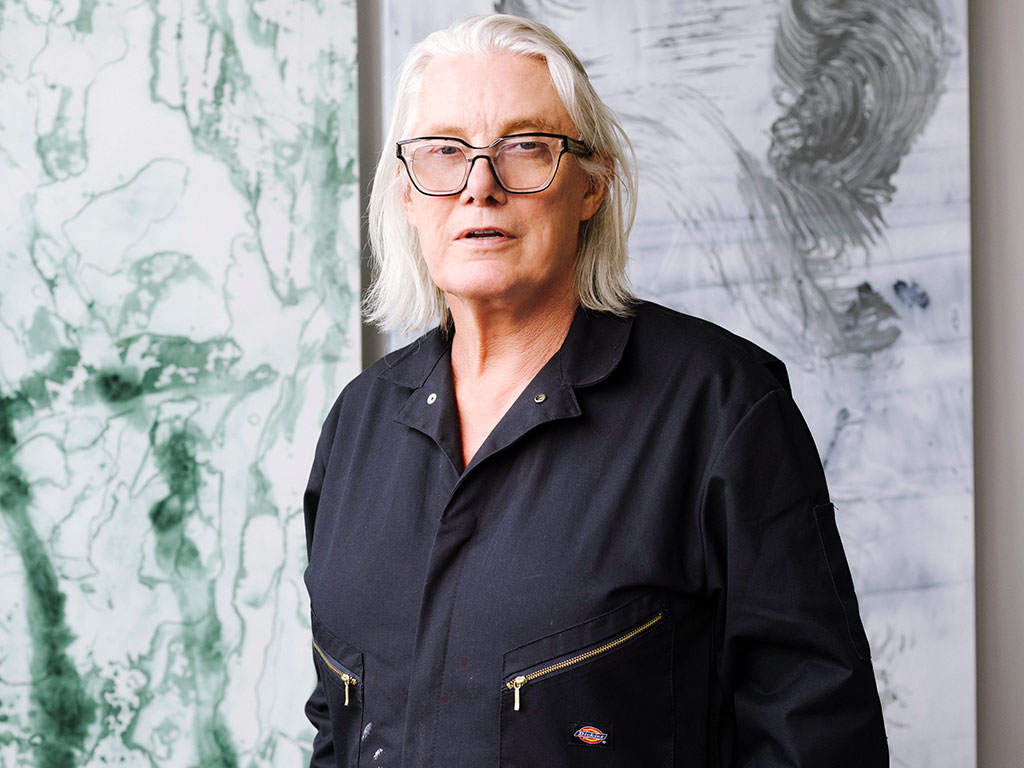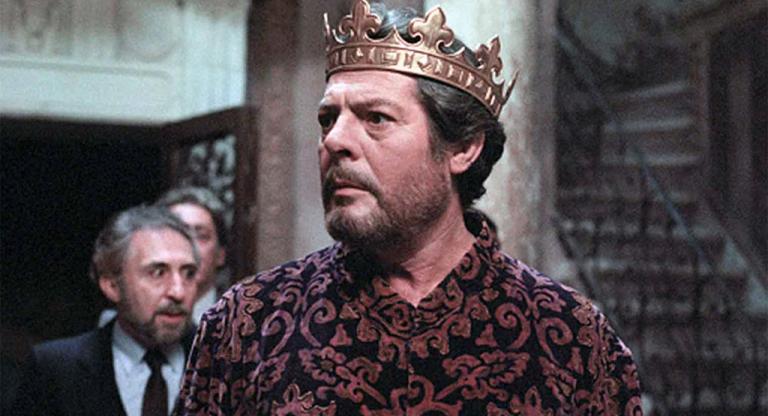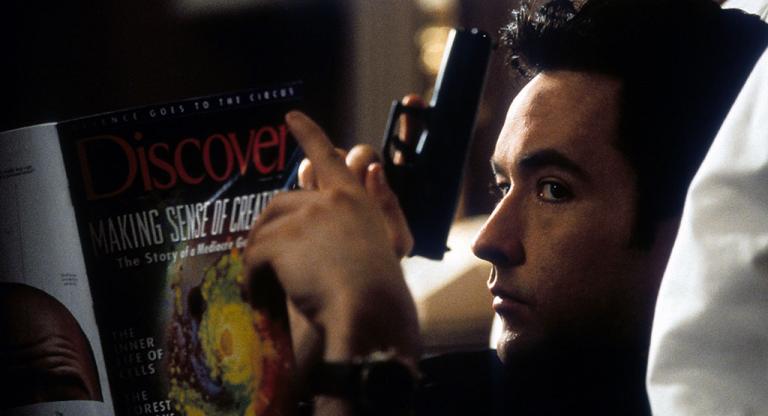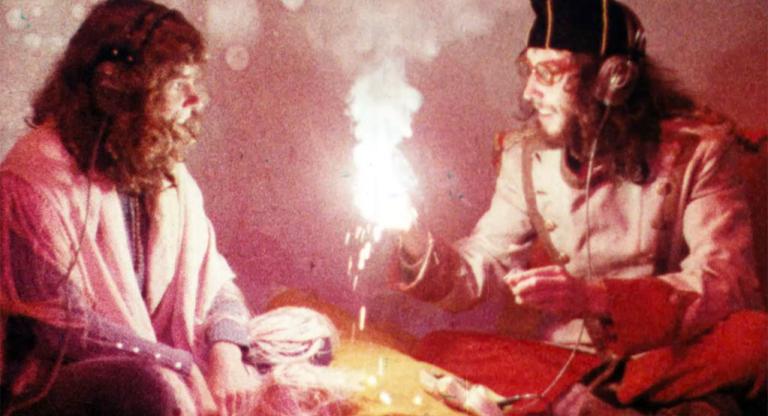The British-born filmmaker, painter, and musician Jamie Nares is one of the foremost chroniclers of New York City. When she left London in the early 1970s, Nares found herself in the midst of New York’s burgeoning No Wave movement. You could spot her everywhere: performing with Jim Jarmusch and The Del-Byzanteens, playing guitar for James Chance and the Contortions, filming fake car crashes with Eric Mitchell, and hosting guerilla film screenings in a garage with Becky Johnston. Now, several decades later, MoMA has mounted a large-scale retrospective of her film work, spanning her earliest short films and features to her more recent work. New York City weaves through all of it, its shapes and inhabitants are the protagonists of Nares’ lens.
I spoke with Nares in advance of the opening night of her retrospective, but I first met Nares while helping archive materials from the No Wave scene in the Department of Film at MoMA. My supervisor for this project was the formidable Ron Magliozzi, who is responsible for mounting this series.
Alexandra Coburn: Can you talk about how this retrospective came together?
Jamie Nares: It came together in almost an offhand moment. I was up at MoMA to look at Arabian Lights [1983], the film I shot with Edit [deAk]. As I was leaving Ron said, “Oh yeah, we want to do a retrospective.” I was like, “What? Did I hear that right? Repeat that.” Because, of course, it's kind of a dream to have such a situation. Ron has been just wonderful.
AC: You’re an artist of many disciplines: painting, music, filmmaking, among many other things, I’m sure. Did these mediums ever interact with or inform the others?
JN: There's always a connection between the films and everything else, maybe particularly in the early ones where I was so focused on these kinds of primal forces at all times. I wasn't making paintings in those days, although the paintings do imply a lot of the same concerns as those early films—gravity and speed and movement and time and light.
AC: There’s a sort of geometry that I noticed, an interest in shapes, symbols and signs. You capture the geometry of New York City.
JN: And the geometry of the human body. But it’s never strictly measured. It’s an intuitive geometry. It’s like my favorite game, which is three-cushion billiards.
AC: In the early ‘70s you moved from London to New York. There’s an element of seeing the city for the first time that I think comes from moving here rather than being born here. There’s a freshness.
JN: I think people who've been born and raised in New York City have a special aura about them, which I love. They know about stuff that other people don't know about. The things I was interested in were a kind of eyes wide open moment. Pendulum [1976] itself has a lot of that in it. I was also casting these concrete balls, like in the film Ramp [1976], and just leaving them around downtown Manhattan. I thought of them as a kind of antidote to the rising city and the rising buildings. So there's definitely a city-consciousness in those films, the measuring of one block in a sort of human way.
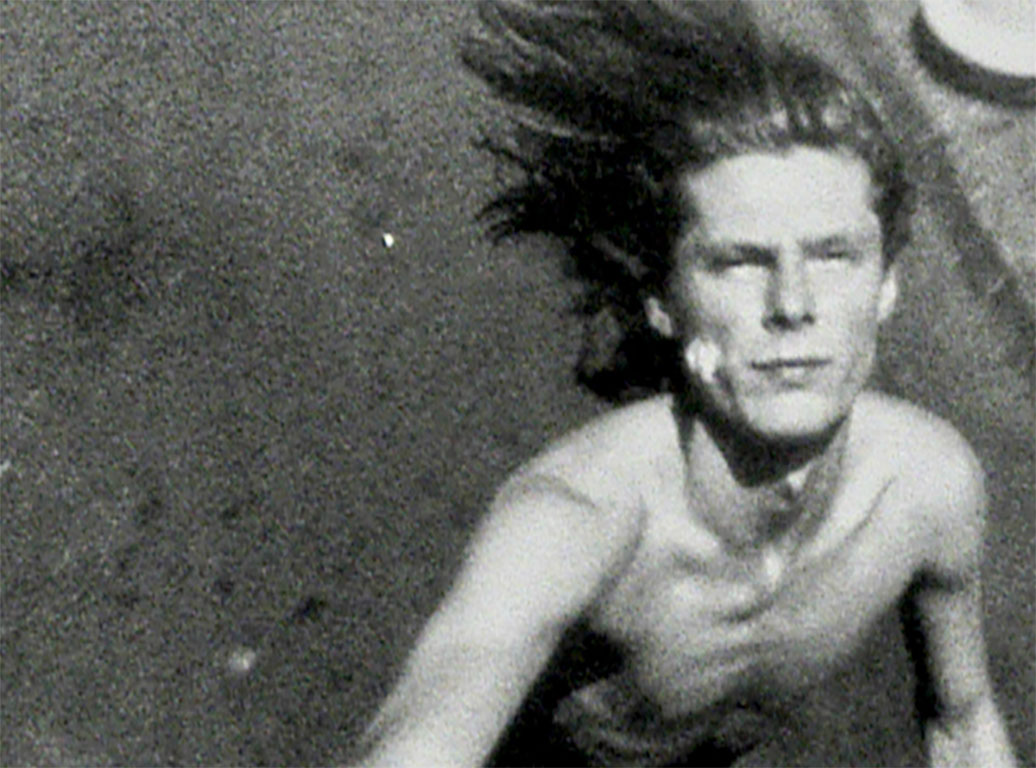
AC: It did seem like the city was almost a playground at that time, especially in the club scene. People were leaving the club and stealing police barricades and making them a part of their performance. It all felt a bit more malleable.
JN: Particularly in the club scene. We were extremely playful. One could go out and roll a concrete ball down the old West Side Highway, and nobody would stop you. No one would blink an eye. You could do things which you just can't do any more.
AC: The Super 8 camera was such a huge part of this as well. It's almost like a natural extension of the arm, more so than even the smallest 16mm cameras. Can you talk about your decision to use Super 8 in your early work?
JN: I loved Super 8 because it created a really beautiful picture, for one thing. It was also very convenient. You could hold it in one hand, throw it up in the air, and catch it if you wanted to… It was very immediate. I loved the units of film that you bought in the little cartridges. You just slapped it in, shot it, and mailed it off to get processed. You could do things with it that were much harder to do with a 16mm camera.
AC: There’s a reason it was the home movie format. It’s like the proletariat film instrument.
JN: Everyone tells me I have to preserve my films on celluloid, even the ones shot on video.
AC: It’s a physicality. You shoot light and it appears on something you can hold. It feels more permanent.
JN: Film is more physical. I like that distinction, because the image itself is more physical. You know, like you say, it's light on a sheet of photosensitive celluloid and then it comes out the other end. I love film for that reason. Super 8 is making such a comeback. I'm amazed.
AC: Speaking of Super 8, Rome ‘78 is like an emblem now of the No Wave movement. It features all these iconic artists and performers, and it’s a primary document of the scene. Did you have the sense at the time that you were creating this record?
JN: Yes, I did. The film is kind of about that, right? It seemed natural to cast all the people I knew. I was kind of typecasting people and writing roles for them. So Eric Mitchell was Metallus, which seemed to suit his character. I'm very touched by history. I like historical things. I just like looking back in time. This sparks my imagination. So, I was aware that I was making a historical film and that one day, it would become history in itself. But I never expected it to take on quite the patina that it has. Because for many years, they were forgotten films. They were gone. And that was that, right? Then suddenly, there was this revival of interest in that whole period and those films; and with good reason, because it was very dynamic. It was a uniquely dynamic, creative, inventive, free time. I feel so blessed to have been part of it. I just walked right into it. I moved here from England and moved right into Tribeca when it was in its prime as a derelict neighborhood to do stuff in.
AC: And there was subsidized artist housing at the time under the New York State government, right? Which now feels impossible.
JN: Yes! Artist-in-residence.
AC: You talk about this period as generative, and you made Rome ‘78 about an iconic period of Roman history featuring now-iconic characters from the No Wave movement. There’s a parallelism. Both eras were ones of extremity and decadence. A No Wave film set in the Roman Empire is the perfect metaphor.
JN: There were elements of that time that were alive and well in New York, a kind of benign disregard for other people's feelings. It was a very conflicted time. There was a lot of violence. It was a different city. There was serious talk in New York City about us seceding from the nation. We thought we were on the edge of the United States, connected to Europe and other places. Me and my friends were all iconic to each other, but none of us were iconic to anyone else. So that’s been a beautiful thing to happen.
AC: I look at the pictures from that era and I’m shocked at how there could be eighty cool people in one room wearing insane outfits who all had separate art careers. It feels like lightning in a bottle.
JN: I like lightning in a bottle. And of course, the interweaving of discipline was a very important and significant aspect. You had dancers and poets and musicians and painters, all these people who came from different disciplines, all suddenly interacting with one another and collaborating without giving it much thought. It's like, “Hey, do you want to do the sound on my movie tomorrow?” “Yeah, okay.”
AC: That leads me to Arabian Lights. Didn’t you and Edit deAk end up in Egypt by accident? How did that come about?
JN: It wasn't planned at all. It was a very spontaneous thing. We were in London at an opening for Francesco Clemente. Later in the evening I think Edit just said, “Let's go to Egypt.” And I said, “Yes. Let's go to Egypt.” And then the next question was, “Where is Egypt?” That's how it began. Then we went and got visas and just went right without knowing anybody or anything. And we happened to go at a time when there had just been a horrible terrorist attack, so there were no tourists. There’s not a single Western presence in Arabian Lights. It’s just me and Edit fooling around at these wonderful sites, enjoying it by ourselves.
AC: It has a historical element like Rome ‘78. You two are wandering around this empty landscape like you’re the last people on earth.
JN: I really didn't appreciate it at the time. Like, I don't remember walking around going, “There's nobody else here.” It was just like, “Here we are. And this is the way it is.”
AC: How were you all exhibiting this at the time? I think you mentioned showing it in a loft somewhere with Yma Sumac records playing.
JN: We showed it in Edit’s loft, and she may have showed it a couple of other places, but the only place I ever saw it was in her loft. She had an analytical projector, so you could vary the speed just by turning a knob. She would vary the speed, and she might slow it down if there was something that she felt good about, or speed it up. And there was a lot of Yma Sumac and Alan Suicide or ‘60s girl groups.
AC: I like the cut and paste element. Like, you can see Unmade Beds [1976] now, and it’s probably not the Unmade Beds people saw when it first came out.
JN: We showed films in lofts against a white wall. My friends and I opened a cinema in the garage of the building where I had my studio, and in the daytime it was filled with four big Cadillacs. In the evening and weekends they were gone, so we made a collapsible screen. We’d scurry in there like roaches and then invite people over. We used to do performances there and show films. We would get very good-sized audiences just by word of mouth from around the neighborhood. Like 150 to 200 people. But sometimes there may be just 10 or 20. We borrowed these little rubber foam squares that belonged to Artists Space—just around the corner—when Cindy Sherman was the girl manning the telephones.
AC: It seemed like you wanted to amass a body of work as fast as you could, like you were constantly doing something.
JN: It was like that, and consciously so. We were conscious that we were making films in the same neighborhood where the old one or two reelers were made at the turn of the 20th century. The ethos was similar. We would want to shoot a film and we’d say, “Okay, let's do it tomorrow. You do this. I'll do that. I'll get the equipment. See you at sundown.” And then we'd make the movie in a day or two. They were quick. They were snappy. They were on target. And they still had some kind of meaning.
Eric Mitchell made a film called Car Crash. You would often see cars up on blocks because the wheels had been stolen. So you'd have a perfectly nice car just sitting on blocks. There was one just around the corner from where we were living and Eric had this film he wanted to make, and he didn't particularly tell us what it was going to be. We got in the car. It was Tina L’Hotsky, myself, and Eric. We all put ourselves in these ridiculous positions where it couldn't possibly be an actual car crash, and then Eric went around covering us with ketchup. So it looked really gnarly. There were people stopping going, “Oh my god, this is awful. What happened?” Eric was under the hood. There was humor in that, which was kind of politically conscious, to allow humor to be there. I was talking with Frank Stella. He was doing a show at Kasmin Gallery, and it was beautiful work. I said to him, “God, Frank, it looks like you really had fun making this.” That was the end of the conversation. He just turned around and walked off. That’s like an insult to his generation, the idea of having fun. So we kind of turned that on its head.
AC: I think that a lot of your features feel special because it’s like being let in on an inside joke. It’s a window into your friendships that comes with the whole home movie or travelog or guerilla filmmaking style. Can you talk about some of your frequent collaborators?
JN: There was Eric Mitchell and Becky Johnston with whom I opened the New Cinema, which I think was the first video movie theater. And there’s a good reason, because we would show films on an Advent TV screen. It was a concave shape,and it sat in the middle of the room with a projector the size of an elephant right in front of it. It had three colored lights: red, green, and blue. That created the image. But to see it, you really had to be sitting right in front of the screen. As you drifted away from that line, the image kind of disappeared. Amy Taubin came to the cinema when it first opened and wrote a famous review, which we never let her forget. She said it was like looking at “bent pink soup,” and that became a kind of rallying cry for us.

AC: Talking about the exhibition element, a lot of the programs in this series at MoMA pair your older work with your newer work. How would you say your relationship with shooting the city has changed over the years?
JN: To start, I never really thought of myself as someone who shot the city. I guess it was just the inevitable backdrop, because that's where I was and it’s remained there. I’m still very true to New York City, in spite of its shortcomings these days. I believe in it.
My last city-centric film was Street [2012], which in many ways is the apotheosis of my New York City filmmaking, because I am involved with the people of New York City for the first time. Maybe that was the end of that for me. After I made that film, people were always asking, “What's next? Street Calcutta?” In fact, Benicio del Toro wanted me to do a version in Havana, but I just didn't want to turn it into that sort of thing. That was a movie I made for New York and I just wanted to let it rest there. I might do a film called Night as a nocturnal version of Street.
But now, at MoMA, I’m premiering a film called Building [2020 - 2024]. I shot it during Covid, when I was stuck in my apartment. I had this bird's eye view of a high-rise going up— it was so interesting and beautiful. I learned so much just by looking down. You got to see all the people and the incredible way that they move around each other, you know, the electricians and metal workers and the carpenters. There's this collaboration between people with different skills. That was nice to see.
AC: I mean, it's highfalutin to say this, but I do feel like with you talking about the collaboration of people with different skills, building this thing all of a sudden, that's the No Wave movement to me.
JN: It’s true! And in Building, you do get familiar with some of the characters. As they build it, it gets closer and closer to where I am, until eventually you get to know these people quite well. You can see which one's the joker and which one's serious, or which one's a bully. It goes up and up and up. And then, it's out of sight.
AC: It seems like there’s a real interest in your films from the younger generation of filmmakers and filmgoers who maybe haven’t been exposed to much No Wave work yet. There’s a real reverence. How do you feel about that?
JN: I love it. I’ve done many things where there was only an audience of two. This is not familiar territory to me. To connect with young people is quite something. The idea that what we did could have sparked something in people several generations away from us, that's quite something. I have three daughters and a stepson. And they're all totally into that period. They're very interested in it. It’s seen as a time of great freedom, which it was. Yes, it really was. And that warms me.
Preoccupations: A Jamie Nares Retrospective runs May 23-June 2 at the Museum of the Modern Art.
